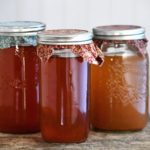How To Make Wine Vinegar
It is really easy to turn wine into homemade wine vinegar. All that you need is two ingredients and a bit of patience!
- Prep Time: 2 minutes
- Total Time: 2 minutes
- Yield: 3 1/4 cups 1x
- Category: Condiments
- Cuisine: Traditional
- Diet: Vegan
Ingredients
Units
Scale
- 3 cups of wine (see above for options)
- 1/4 cup of apple cider vinegar with a mother (see notes)
Instructions
- Mix the wine and the vinegar mother in a glass jar. I don’t recommend using plastic or metal because they may react to the acidity in the vinegar. Shake the vinegar bottle before measuring to ensure that the vinegar is well mixed.
- Cover the jar with a cloth or coffee filter held in place with a rubber band or jar ring.
- Place the jar somewhere dark and at room temperature to ferment. I usually stash all my vinegar in a closet.
- Leave the wine to ferment for 2 months.
- At some point, the wine may smell bad, like nail polish remover. That is part of the process as ethanol is converted to acetaldehyde before turning into acetic acid.
- The vinegar is ready when it is sour. You can either use a kit to test the pH or taste it. If it’s sour then it’s ready to be bottled.
- Store finished vinegar in an air-tight bottle. I recommend letting it age for another month or two. While it won’t become more acidic, aging will help to develop the flavor.
- Homemade vinegar will last for years in a dark location. The flavor will likely continue to improve as it ages. (True balsamic vinegar is aged for over 12 years!)
Notes
- Wine may naturally ferment into vinegar, but adding a bit of acetic acid bacteria is definitely recommended.
- Make sure that the apple cider vinegar contains a mother. Look for brands labeled raw, unpasteurized, or with mother.
- Often a thick rubbery disk will form on top of the vinegar. It’s called a vinegar pellicle, and it is perfect for culturing future batches of vinegar. Save it and use it instead of the ACV.
Find it online: https://www.fermentingforfoodies.com/how-to-make-wine-vinegar/
